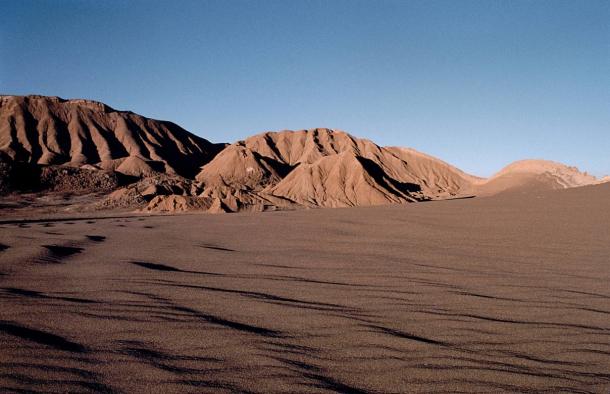
7,000-year-old Chinchorro mummies are turning gelatinous
The Chinchorro mummies of Chile survived more than 7,065 years without deteriorating until about 10 years ago, when moisture began to allow bacterial growth that is making them turn gelatinous and black, says an American university professor who examined the mummies. Experts are taking steps to preserve them.
Moisture in the air and on the mummies is allowing bacteria to grow, said Ralph Mitchell, a Harvard University professor emeritus of applied biology. About 120 mummies, which radiocarbon dating date from 5050 BC and before, are rapidly deteriorating in the archaeological museum of the University of Tarapacá in Arica, Chile, on the northwest coast of that South American country.
The university is near the Atacama Desert, in some parts of which it hasn’t rained for nearly 400 years.

Valley of the Moon in the Atacama Desert (Reinhard Jahn Mannheim/Wikimedia Commons)
Archaeologists say the Chinchorro people mummified the deceased from all levels of society, even fetuses. They appear not to have had a rigid social hierarchy in life, too, unlike other civilizations. The Chinchorro people inhabited the coast of the Atacama Desert in northern Chile and southern Peru between 7000 and 1500 BC. They relied on fishing, hunting and gathering for food. The earliest known Chinchorro sites date to 7000 BC.
The Chinchorro mummies were first identified in 1917 by the German archaeologist Max Uhle. Further excavations showed mummies were spread along the coast and concentrated between Arica and Camerones. In 1983 the largest and best-preserved find of Chinchorro mummies was made by the Arica water company while laying a new pipeline near the foot of El Morro.
MORE
- The 7,000-Year-Old Chinchorro Mummies of the Andes
- School children uncover 7,000-year-old mummy in Chile
In a fitting find in April 2014, at-risk children on an archaeological field trip to help them identify with their heritage found a 7,000-year-old mummy. The ground-breaking find was made during a visit to the Morro de Arica site on El Laucho beach in Arica. The area had been hit by a massive 8.2 magnitude earthquake on 1 st April, and many archaeological artifacts have been uncovered following a series of landslides triggered by the quake, including Inca silver, spearheads, pottery and clothing.

Chilean children, at the site of a mummy they found after an earthquake in April 2014 turned over earth, revealing ancient remains and artifacts. (Photo courtesy of La Tercera)
The discovery was made by accident, when one of the students noticed a strange shape in the ground, which turned out to be a mummy dating back to the ancient Chinchorro period.
Changing climate in Chile could be the reason for the deterioration of the mummies in the museum, Marcela Sepulveda told Live Science. She is an archaeology professor at the University of Tarapacá. Researchers found mummies begin to rot quickly after 21 days of high humidity. To preserve the mummies, the humidity in the room will need to be kept at between 40 to 60 percent. At more than 60 percent they could rot and disintegrate; at less than 40 percent their skin could be damaged.
Unless experts can take measure to regulate the temperature and humidity where the mummies are stored, Mitchell told Live Science, "the native microorganisms are going to chew these guys right up.”
The Chinchorro mummies appear to reflect the spiritual beliefs of the ancient Chinchorro people, although why they mummified their dead is unknown. Some scholars maintain that it was to preserve the remains of their loved ones for the afterlife, while another commonly accepted theory is that there was an ancestor cult of sorts. There is evidence of both the bodies traveling with the groups and of being placed in positions of honor during major rituals, as well as a delay in the final burial itself.
Unlike the ancient Egyptians, who reserved mummification for royalty and the elite, the Chinchorro community accorded everyone, regardless of age or status, this rite. The decision of egalitarian preservation is proven in the mummification of all members of society and included men, women, the elderly, children, infants, and miscarried fetuses. In fact, it is often the case that children and babies received the most elaborate mummification treatment.
One explanation for this egalitarian funerary practice is climate. As the Atacama Desert is one of the driest places on earth, corpses would have been preserved naturally. Moreover, as the Chinchorros buried their dead in shallow graves, it is likely that the bodies were partially exposed by winds. As the level of seawater increased around 6000 to 7000 years ago, the amount of marine resources also increased, which in turn supported a larger population. As the group size increased, there would be a greater exchange of ideas, leading to more prosperity and cultural complexity, one of them would be the practice of mummification. Perhaps one of the most interesting aspects of the Chinchorros is that, based on the available evidence, it appears that social hierarchy was not developed, unlike other early civilizations. How this culture managed to remain egalitarian for many millennia and function at a social level without hierarchy is something that has intrigued archaeologists and anthropologists for decades. Research into this aspect of their culture is ongoing.
Featured image: The head of an ancient Chinchorro mummy from northern Peru that had not been rotting (Photo by Pablo Trincado/Wikimedia Commons)
By Mark Miller















